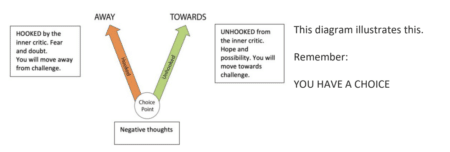We all know the voice in our head that criticises, belittles, and judges us. This voice has many names: inner critic, judge, saboteur, the superego, pesky critter, negative self-talk…
And those negative thoughts use up a lot of our brain power – it has been estimated that 80% of our thoughts are negative and 95% of those are recurring (according to the National Science Foundation)…which can end up giving us a highly skewed perception of our experience.
Our inner critic keeps us small by giving threat and fear more airtime than hope and possibility. That little voice, especially if we are unaware of it, can stop us from doing what excites us, what enables us to grow and what allows us to achieve our potential.
But it doesn’t have to!
What Is the Inner Critic ?
There are a few things that you should know about this voice :
- It is largely subconscious
- The roots of the inner critic are often found in childhood and laid down at an early age (sometimes it is a voice of a parent or other authority)
- The negativity is evolutionary, driven by our ancient fight-flight mechanism. The ability to detect danger in our environment, as cavepeople, was vital to our survival. This still operates today and is called our ‘negativity bias’.
- It thinks it does an important job – to keep us safe, stop us from taking risks and getting into danger. However it hasn’t caught up with the safe world we now live in.
First, practice noticing and identifying the voice of the inner critic. You then have a choice – you can unhook from the inner critic and move TOWARDS taking action, or get hooked and allow the thoughts to take you AWAY from challenge and growth.
Strategies for ‘unhooking’ from your inner critic
Fortunately, there are effective strategies for weakening the power of the inner critic, so the ‘towards’ action becomes easier and more joyful.
I have given you 5 exercises here. Try them all, some will work for you, others may not. They are short, so I suggest you get a cuppa, give yourself 30 minutes of ‘me time’ and play.
The aim of these exercises is NOT to rid you of the inner critic – it is too ancient and embedded for that. It is actually to befriend it. You will still hear it, but YOU WON’T LET IT DRIVE YOU… Read on!
The exercises
Before all these exercises I suggest you ground yourself. Breathe in and out slowly 3 times and centre yourself. Remember that the negative thoughts produce emotional discomfort. Be present with that, allow it. This feeling has stopped you from moving forward in the past but it doesn’t have to stop you now. This doesn’t happen overnight. It takes time, but if you are committed to going TOWARDS what you want, and you use these exercises, you WILL move past your inner critic.
1. You are a resourceful adult !
Remember that your inner critic is the age you were, when it first showed up…. which could as young as 3, 4, 5 years old…
…so listening to your inner critic is a bit like taking advice from a small child.
Instead:
- Give it love. Whenever we hear the voice of our inner critic, we may practice thinking, “Bless you little one” “Thank you, inner critic. I appreciate you keeping me safe, but I have got a handle on this’. ‘Thank you darling, but I’ve got this’.
- Play with seeing it in the 3rd person or as a character: “There’s the inner critic off again….” Aha, my inner critic professor is positing the theory that I am ugly and stupid.” Or personify it as a silly looking creature.
- When you notice a recurrent theme, acknowledge and name it: “There’s my “Not good enough story”, or “Here we go – it’s Predicting the Worst”, or Look, it’s doing it’s “Worrying”, or “Dwelling on the past” or “Doubting myself” or “Judging myself”.
We can thank the critic for its care and appreciate its good intentions, while also deciding that it is ultimately in our adult power to follow its advice or not.
- What can you say to your inner critic that will soothe it and help it feel safe?
- What is a more true and liberating story than the one that it tells?
- What resources do you have as a capable adult to support you now?
- How can you give your inner critic the day off?
Remind yourself of all the times your critic said ‘you can’t do this’ – and you went ahead anyway and proved it completely wrong.
2. Towards and Away
Ground yourself with 3 breaths. Jot down several of the thoughts that frequently hook you.
Draw your own version of the away and towards diagram. Next to the Away arrow, write the thoughts, the feelings and behaviours created when you get hooked into the negative thoughts of the inner critic, then for the Towards arrow write what you would rather think, feel and do. This is a great exercise for building motivation and awareness.
3. Drifting off
If you like guided meditations, visualisation or imagery you may want to try this.
Start by grounding yourself with 3 deep and slow breaths. You may like to lie down and get very relaxed.
Imagine the negative thoughts are light and can just drift away – put the thought on a leaf and watch the leaf drift down a stream, or blow it into an imaginary balloon and watch the balloon as it floats and gets smaller and smaller in the sky, or watch it get written on the sand and see it get washed away by the sea, or even see it in a picture frame in a gallery and then walk further and further away from it.
Come up with your own creative visual metaphors for this and have fun with it !
4. Wave the Magic Wand
When you hear the inner critic, just stop and ask yourself these questions.
I suggest you write down the answers, because writing gets it out of your head. State the facts without emotion or drama. Ground yourself with 3 breaths.
- Is it true?
- Are there any specific elements that are actually true? Acknowledge them.
- Is this what I really want?
- What do I want instead?
- How can I take action on this – even in a small way?
- What would that bring me?
5. ‘Yes…. and’
There’s a popular improvisation comedy tool you can steal for managing your inner critic: “yes, and…” In improv, instead of replying “no” to someone, you reply “yes, and…”, which means that you’re listening to your partner’s ideas, agree with the premise, and then contribute additional thoughts.
Here’s how to apply it to your self-talk: Let’s say your inner critic is telling you something like, “I never do anything right.” Instead of trying to fight the thought, acknowledge it, because there may be some truth to it. Then, more importantly, focus on what other facts might also be true. For example, “Yes, I may have made a mistake, and I can learn from it to make changes next time.” OR “That’s curious that my critic is saying I’m rubbish…. Yes sometimes I am, however, right now – I’m doing well… I’m running a company that is making profit, with happy clients”
This works WITH your brain – affirmations like “I do everything right and all happens perfectly” may sound lovely but often your brain rejects it because it completely contradicts what the brain has habitually come to see as truth “I never do anything right”. Acknowledging some truth means it’s easier to retrain the brain.
In summary…
The biggest factor in any exercise is that you have to apply it. How many courses have we all done that we simply didn’t apply consistently, and so made very little difference?
So I invite and encourage you to take the exercise that most resonates with you or you most enjoy and consistently do it, for at least a week. Then notice the change.
Happy Times with your Inner Critic!
If you find yourself stuck but really want be BOLD and audaciously you, book in a no obligation clarity call where we will uncover exactly how you can overcome your blocks and take action on your vision. https://calendly.com/thefreedomformula/clarity-call
Sharon Baker, Transformational Life Coach
www.freedomformula.co.uk












